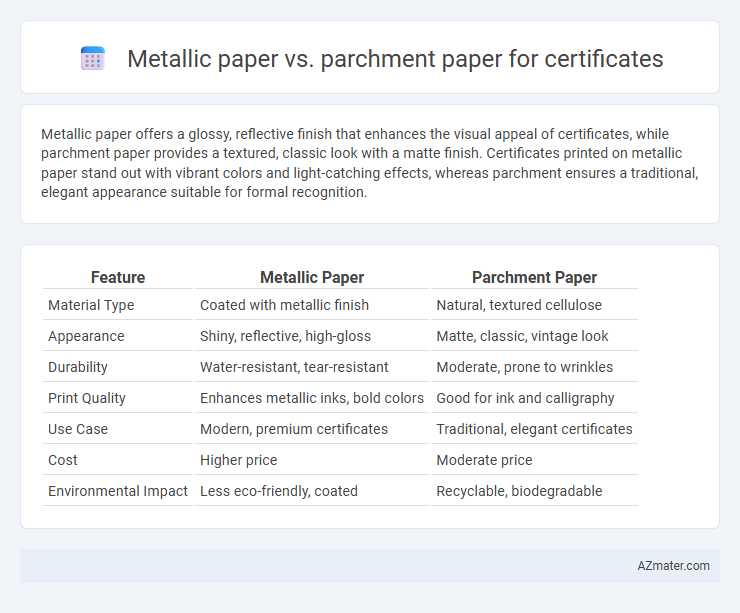Metallic paper offers a glossy, reflective finish that enhances the visual appeal of certificates, while parchment paper provides a textured, classic look with a matte finish. Certificates printed on metallic paper stand out with vibrant colors and light-catching effects, whereas parchment ensures a traditional, elegant appearance suitable for formal recognition.
Table of Comparison
| Feature | Metallic Paper | Parchment Paper |
|---|---|---|
| Material Type | Coated with metallic finish | Natural, textured cellulose |
| Appearance | Shiny, reflective, high-gloss | Matte, classic, vintage look |
| Durability | Water-resistant, tear-resistant | Moderate, prone to wrinkles |
| Print Quality | Enhances metallic inks, bold colors | Good for ink and calligraphy |
| Use Case | Modern, premium certificates | Traditional, elegant certificates |
| Cost | Higher price | Moderate price |
| Environmental Impact | Less eco-friendly, coated | Recyclable, biodegradable |
Introduction to Certificate Paper Types
Metallic paper offers a glossy, reflective finish that enhances the visual appeal and vibrancy of certificates, making them stand out with a premium, professional look. Parchment paper features a textured, antique appearance providing a classic, elegant aesthetic often associated with official and prestigious documents. Choosing between metallic and parchment paper depends on the desired certificate style, durability, and impression for formal presentations or awards.
Overview of Metallic Paper
Metallic paper offers a unique, glossy finish that enhances the visual appeal of certificates with its reflective and vibrant surface, making awards and recognitions stand out. This paper type is durable and resistant to smudging, ensuring certificates maintain their pristine look over time. Its compatibility with various printing techniques, including laser and inkjet, provides flexibility for high-quality, professional-grade certificate production.
Overview of Parchment Paper
Parchment paper is a high-quality, durable material known for its smooth surface and classic, elegant appearance, making it ideal for certificates that require a traditional and professional look. It is acid-free and resistant to yellowing, ensuring the longevity of important documents. Unlike metallic paper, parchment paper offers a subtle texture that enhances the readability of printed text and is widely preferred for formal certificates and diplomas.
Appearance and Aesthetic Differences
Metallic paper offers a shiny, reflective surface that enhances the visual impact of certificates with a luxurious and modern feel, while parchment paper presents a classic, textured matte finish that evokes a traditional and elegant appearance. The smooth, glossy finish of metallic paper highlights vibrant colors and intricate designs, making certificates stand out, whereas parchment paper's subdued tones and natural fiber texture provide a sophisticated and timeless aesthetic. These distinct surface qualities influence the overall presentation, with metallic paper being ideal for contemporary, eye-catching awards and parchment paper suited for formal, heritage-inspired recognitions.
Texture and Feel Comparison
Metallic paper offers a smooth, glossy texture with a reflective sheen that enhances the visual appeal of certificates, providing a luxurious and modern feel. Parchment paper features a slightly rough, fibrous texture that mimics traditional handwritten documents, giving certificates a classic, timeless elegance. The tactile contrast between the slick surface of metallic paper and the matte, textured finish of parchment paper impacts the overall impression and durability of certificates.
Durability and Longevity
Metallic paper offers superior durability and resistance to wear, making certificates more resilient against moisture, tearing, and fading over time compared to parchment paper. Parchment paper, while aesthetically classic, is more prone to creases and environmental damage, reducing long-term preservation. Certificates printed on metallic paper maintain a vibrant, professional appearance longer, ideal for important documents requiring extended longevity.
Printing Compatibility
Metallic paper offers a glossy finish enhancing vibrancy in certificate printing but may require laser printers to avoid smudging, as inkjet printers can struggle with ink adhesion. Parchment paper provides a textured, classic look compatible with most inkjet and laser printers, ensuring reliable ink absorption and crisp text reproduction. When selecting for certificate printing, laser printers paired with parchment paper generally yield the most consistent and professional results.
Cost Effectiveness
Metallic paper for certificates offers a premium look but comes at a higher cost per sheet compared to parchment paper, which is more budget-friendly and widely available. Parchment paper provides a classic and elegant appearance suitable for most certifications without significantly increasing expenses. For cost-effective certificate printing, parchment paper balances quality and price, making it ideal for bulk orders or institutions with tight budgets.
Best Use Cases for Each Paper
Metallic paper is ideal for certificates that require a luxurious, eye-catching finish with vibrant colors and reflective qualities, making it perfect for awards, commemorative documents, and special event certificates. Parchment paper offers a classic, textured appearance that suits formal certificates, diplomas, and legal documents where a traditional and professional look is desired. Choosing metallic paper enhances visual impact and prestige, while parchment paper emphasizes authenticity and timeless elegance.
Choosing the Right Paper for Certificates
Metallic paper offers a shiny, luxurious finish that enhances the visual appeal of certificates, making them stand out for special achievements and awards. Parchment paper provides a traditional, elegant texture with a classic, timeless look ideal for formal certificates and official documents. Selecting the right paper depends on the desired aesthetic and purpose, with metallic paper suited for modern, eye-catching designs and parchment for a more sophisticated, traditional presentation.

Infographic: Metallic paper vs Parchment paper for Certificate
 azmater.com
azmater.com